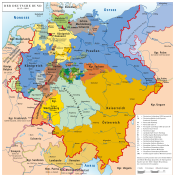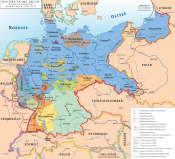Бремен (штат)
Бесплатный Гансейский город Бремен
Бесплатный Гансейский город Бремен ( немецкий ) Бесплатный Гансейский город Бремен ( низкий немецкий ) | |
|---|---|
 | |
 | |
| Coordinates: 53°20′50″N 8°35′29″E / 53.34722°N 8.59139°E | |
| Country | Germany |
| Capital | Bremen |
| Government | |
| • Body | Bürgerschaft of Bremen |
| • Senate President and Mayor | Andreas Bovenschulte (SPD) |
| • Governing parties | SPD / Alliance 90/The Greens / The Left |
| • Bundesrat votes | 3 (of 69) |
| • Bundestag seats | 5 (of 736) |
| Area | |
| • City | 419.38 km2 (161.92 sq mi) |
| Population (2020-12)[1] | |
| • City | 680,130 |
| • Density | 1,600/km2 (4,200/sq mi) |
| GDP | |
| • Total | €38.698 billion (2022) |
| • Per capita | €56,901 (2022) |
| Time zone | UTC+1 (CET) |
| • Summer (DST) | UTC+2 (CEST) |
| ISO 3166 code | DE-HB |
| Vehicle registration |
|
| NUTS Region | DE5 |
| HDI (2021) | 0.954[3] very high · 4th of 16 |
| Website | bremen.de |
Бремен ( Немецкий: [Bʁeːmen] ), официально бесплатный Гансейский город Бремен ( немецкий : Фри Хансестадт Бремен ; низкий немецкий : бесплатный Хансестадт Бремен ), является самым маленьким и наименее густонаселенным из 16 штатов Германии . Это неофициально называется Land Bremen («Состояние Бремена»), хотя этот термин иногда используется в официальных контекстах. Государство состоит из города Бремен и его морского порта , Бремерхавен , окруженного большим состоянием Нижнего Саксонии в северной Германии.
География
[ редактировать ]Состояние Бременского состоит из двух незаметных территорий. Эти анклавы содержат Бремен , официально «город» ( Stadtgemeinde Bremen ), который является столицей штата, и город Бремерхавен ( Stadt Bremerhaven ). Оба расположены на реке Уэзер ; Бремерхавен («Гавань Бремена») находится вниз по течению у устья Уэзера с открытым доступом к Северному морю . Оба анклава полностью окружены соседним штатом Нижняя Саксония ( Нидерсхсен ). Самая высокая точка в штате находится в парке Фридехорст (32,5 метра; 107 ').


History
[edit]When the Holy Roman Empire was dissolved in 1806, what had been since 1646 (after earlier privileges of autonomy of 1186) the Free Imperial City of Bremen was not mediatised. Rather than being incorporated into the enlarged territory of one of the surrounding monarchies, it was recognised (along with Hamburg) as a sovereign Free Hanseatic City. Its currency until 1873 was the Bremen thaler.
In 1811, in an effort to enforce Napoleon's Berlin Decree embargoing Britain, the First French Empire had annexed the city-state. But at the Congress of Vienna of 1815, Bremen's emissary, and later burgomaster, Johann Smidt, lobbied successfully to have the city's independence restored as one of the 39 sovereign states within the new German Confederation.
In 1827, Bremen bought land at the mouth of the Weser from the Kingdom of Hanover, in order to build a new seaport, Bremerhaven. This ensured that Bremen remained Germany's main port of embarkation for emigrants to the Americas, and that it developed as an entrepôt for Germany's late developing colonial trade.
In 1867, the year following Prussia's defeat of Austria and its annexation of Hanover, Bremen joined the North German Confederation. In 1871, following victory over the French, this became the German Empire with Bremen as one of the Reich's 26 constituent states.
As an international port and industrial centre, Bremen had a strong left and liberal tradition. In January 1913, at the last elections to the Imperial Reichstag in Berlin, the Social Democrats (SPD) secured over half the vote, or 53.4%. Left Liberals (Linksliberale) took another 41.4%. Only 5.1% went to the Conservatives.[4] During the Weimar Republic, there were seven elections to the Burgerschaft, the Bremen parliament. At the November 1932 German federal election, the last broadly free election during this time, the Social Democrats won 31.2% of the vote, and the Communists (KPD) 16.8%, compared to 20.8% for the Nazis.[5][6]
Following the heavily compromised national elections of March 1933, the Nazis still achieved only a third of the popular vote in Bremen (32.7%).[5] Bremen, like all the German states, then underwent the process of Gleichschaltung (coordination) whereby the Nazi regime, through a campaign of violent demonstrations and intimidation, first forced the resignation of the executive Senate and later dissolved the Bürgerschaft. Bremen remained for the next twelve years under the direct authority of a Reichsstatthalter (Reich Governor) who simultaneously held the post of Nazi Party Gauleiter of Gau Weser-Ems. During these years, Bremen's small Jewish community (1,438 people registered at the beginning of 1933)[7] was destroyed through coerced emigration and deportation to death camps in the occupied east.
Allied bombing during World War II destroyed or severely damaged 60% of the city's built fabric, including much of its historic centre. Following a further bombardment, British troops entered Bremen in late April 1945. Transferred to the Americans, Bremen became the supply port for the US zones of occupation in west Berlin and southern Germany.
The city was reestablished as a state in 1947 and, from 1949, was again known as the Free Hanseatic City of Bremen, becoming a Land or state of the new Federal Republic of Germany, informally referred to as "West Germany" until 1990.
Politics
[edit]Political system
[edit]This section needs expansion. You can help by adding to it. (November 2009) |
The legislature of the state of Bremen is the 87-member Bürgerschaft (citizens' assembly), elected by the citizens in the two cities of Bremen and Bremerhaven.
The executive is constituted by the Senate of Bremen, elected by the Bürgerschaft. The Senate is chaired by the President of the senate (Senatspräsident), who is also one of the mayors of the city of Bremen (Bürgermeister) and is elected directly by the Bürgerschaft. The Senate selects of its members as a second mayor who serves as deputy of the president. In contrast to the Federal Chancellor of Germany or other German states, the President of the Senate has no authority to override senators on policy, which is decided upon by the senate collectively. Since 1945, the Senate has continuously been dominated by the Social Democratic Party.
On a municipal level, the two cities in the state are administered separately:
- The administration of the city of Bremen is headed by the two mayors and controlled by the portion of the Bürgerschaft elected in the city of Bremen (72 members).
- Bremerhaven, on the other hand, has a municipal assembly distinct from the state legislature and an administration under a distinct head mayor (Oberbürgermeister) and a distinct second mayor.
Political majorities
[edit]In post-war Bremen, the port, shipyards and related industries sustained a large and unionised working class. As before 1933, this translated into support for the Social Democrats, considered Bremen's natural governing party. However, in the 1980s mechanisation of the port and closure of the city's leading shipbuilder induced an employment crisis and shook the confidence of the party's traditional voter base. The SPD, which had still polled 51% in 1987, lost its effective majority.[9] The once dominant left-liberal vote split, and coalition government became the norm.
The 2019 Bremen state election was held on 26 May 2019 to elect the members of the Bürgerschaft of Bremen, as well as the city councils of Bremen and Bremerhaven. The election took place on the same day as the 2019 European Parliament election.[10][11][12] The Christian Democratic Union (CDU), for the first time, became the largest party in the Bürgerschaft, while the Social Democratic Party (SPD) fell to second place. The Greens and The Left made small gains. After the election, the SPD, Greens, and Left agreed to form a coalition government. Carsten Sieling resigned as mayor and was replaced by fellow SPD member Andreas Bovenschulte.[13][14]
| Party | Votes | % | +/- | Seats | Total seats |
+/- | Seats % | ||
|---|---|---|---|---|---|---|---|---|---|
| Bremen | Bremerhaven | ||||||||
| Christian Democratic Union (CDU) | 391,709 | 26.7 | 20 | 4 | 24 | 28.6 | |||
| Social Democratic Party (SPD) | 366,375 | 24.9 | 19 | 4 | 23 | 27.4 | |||
| Alliance 90/The Greens (Grüne) | 256,181 | 17.4 | 13 | 3 | 16 | 19.0 | |||
| The Left (Linke) | 166,378 | 11.3 | 9 | 1 | 10 | 11.9 | |||
| Alternative for Germany (AfD) | 89,939 | 6.1 | 4 | 1 | 5 | 6.0 | |||
| Free Democratic Party (FDP) | 87,420 | 5.9 | 4 | 1 | 5 | 6.0 | |||
| Citizens in Rage (BiW) | 35,808 | 2.4 | 0 | 1 | 1 | 1.2 | |||
| Die PARTEI (PARTEI) | 24,433 | 1.7 | 0 | 0 | 0 | ±0 | 0 | ||
| Free Voters (FW) | 14,205 | 1.0 | 0 | 0 | 0 | ±0 | 0 | ||
| Pirate Party Germany (Piraten) | 14,143 | 1.0 | 0 | 0 | 0 | ±0 | 0 | ||
| Others | 22,915 | 1.6 | 0 | 0 | 0 | ±0 | 0 | ||
| Total | 1,469,506 | 100.0 | 69 | 15 | 84 | ||||
| Voter turnout | 64.1 | ||||||||
Coat of arms
[edit]The coat of arms and flag of Bremen state include:
-
Flag of Bremen
-
Greater coat of arms
-
Medium coat of arms
-
Lesser coat of arms
-
Coat of arms symbol
Economy
[edit]Bremen's post-World War II economy boomed in line with the West German Wirtschaftswunder of the 1950s and 60s. This saw the growth, and permanent settlement, in Bremen of a large migrant worker population, drawn largely from Turkey and southern Europe.
Some of the city's heavier industries failed to recover from the oil-price-shock recession of the early 1970s. Specialist construction yards, ship outfitters and parts suppliers remain, but AG Weser (which employed 16,000 workers at its peak) and Bremer Vulcan, Bremen's major shipbuilders, closed in 1983 and 1997 respectively. Further job losses were caused by the restructuring and increasing mechanisation of harbour-related activities and other industrial sectors. Semi and unskilled harbour workers found it very difficult to re-enter the labour market, and unemployment—for a period in the 1980s almost double the West German average—remained comparatively high.
At a time when structural change in the economy has forced Bremen to spend more on social services, suburbanisation has reduced population and tax revenue, namely due to 1969 federal tax reform - before that, income taxes would be collected by the municipality of the workplace, but after that, by the municipality of the residency. Incorporating surrounding suburban municipalities, is not an option for Bremen as these belong to the state of Lower Saxony.[15]
With financial assistance from the European Union, and from the Federal Government, economic policy has focused on supporting those established economic sectors that are based on advanced technology, such as aerospace and aircraft production, automobile production, maritime and logistics services, and on developing the education and business-park infrastructure for new science-based and digital enterprises. In this an important role is accorded to the growing university sector. Further investment went into the revitalisation of the city centre but a culture-driven regeneration around entertainment and tourism was not very successful. Several experts described Bremen's service sector as underdeveloped, due to a lack of major company headquarters.[15]
Unemployment
[edit]At the turn of the new century, unemployment in Bremen stood at 13%, a rate matched in the Federal Republic only by the "new states" in former East Germany. By 2022, while reduced to 10.2% it was the highest among all 16 German states.[16]
| Year[17] | 2000 | 2001 | 2002 | 2003 | 2004 | 2005 | 2006 | 2007 | 2008 | 2009 | 2010 | 2011 | 2012 | 2013 | 2014 | 2015 | 2016 | 2017 | 2018 | 2019 | 2020 | 2021 |
|---|---|---|---|---|---|---|---|---|---|---|---|---|---|---|---|---|---|---|---|---|---|---|
| Unemployment rate in % | 13.0 | 12.4 | 12.5 | 13.2 | 13.2 | 16.8 | 14.9 | 12.7 | 11.4 | 11.8 | 12.0 | 11.6 | 11.2 | 11.1 | 10.9 | 10.9 | 10.5 | 10.2 | 9.8 | 9.9 | 11.2 | 10.7 |
Industries
[edit]Despite historic job losses in the industrial sector, Bremen State has retained, and continues to develop, a broad manufacturing base:
- Automotive with Mercedes-Benz factory, which is main manufacturing base of C-Class (12,500 employees). Automotive components from Hella and Lear. Assembly lines for powertrain and batteries are supplied from ThyssenKrupp Automation Engineering.
- Aerospace with Airbus aircraft component factories (4,100 employees), rocket components Ariane (550 empl.) and spacecraft OHB (1,200 empl.)
- Iron & Steel with large ArcelorMittal work (3,000 employees);
- Electronic manufacturers for naval/marine Atlas Elektronik (1,400 employees) and defence Rheinmetall Defence Electronics (1,200 employees)
- Shipbuilding represented Lürssen Bremen features the full spectrum of construction, production and assembly facilities for superyachts greater than 100 in length (1,200 employees).
- Food manufacturing of coffee (Kraft, Jacobs, Melitta, Eduscho, Azul), chocolate (Hachez), beer (Beck's Brewery), cereal food (Kellogg's), fish (Frosta, Frozen Fish, Deutsche See), dairy products (DMK Deutsches Milchkontor), pet food (Vitacraft)
Образование
[ редактировать ]Университет Бремена является крупнейшим университетом в Бремене. Это один из 11 учреждений, классифицированных как «элитный университет» в Германии, и преподает около 23 500 человек из 126 стран. У Бремена также есть Университет искусств, Бремен , Университет прикладных наук в кампусах как в Бременском городе, так и в Бремерхавен , а в последнее время в Университете Джейкобса Бремен , Международный исследовательский университет, расположенный в Вегесаке .
Смотрите также
[ редактировать ]- Бомбардировка Бремена во Второй мировой войне
- Бывшие страны Европы после 1815 года
- Временная шкала истории Бремена (город)
Ссылки
[ редактировать ]- ^ «Население, площадь - текущие статистические отчеты - развитие населения в штате Бремен» . Статистический государственный офис в Бремене (на немецком языке). Сентябрь 2018 года. [ Постоянная мертвая ссылка ]
- ^ «Валовой внутренний продукт, создание валовой стоимости | statistikportal.de» . Статистические офисы федеральных правительств и правительств штатов Общий статистический портал (на немецком языке) . Получено 31 июля 2023 года .
- ^ «Субнациональная база данных HDI-область-глобальная лаборатория данных» . HDI.globaldatalab.org . Получено 13 сентября 2018 года .
- ^ «Рейхстаг 1867-1918-Бремен» . Wahlen-in-deutschland.de . Получено 17 мая 2021 года .
- ^ Jump up to: а беременный "Reichstagswahlen 1919-1933-Бремен" . Wahlen-in-deutschland.de . Получено 17 мая 2021 года .
- ^ Герберт Шварцвалдер (1983) Бремен в Республике Веймар (1918–1933) (История свободного Гансисского города Бремен, том 3), христиане, 1983, с. 609
- ^ Герберт Шварцвалдер (2003), Великий Бремен Лексикон . Издание Temmen, ISBN 3-86108-693-X , с. 442.
- ^ Евангелическая церковь в Германии - члены церкви по состоянию на 31 декабря 2018 года EKD, январь 2020 года.
- ^ «Гражданские выборы Бремен с 1945 года - приводит к городу Бремен» . Kahlen-in-deutschland.de . Получено 19 мая 2021 года .
- ^ «Гражданские выборы 2019 года в Бремене: самые важные факты с первого взгляда» . Merkur.de (на немецком языке). 5 апреля 2019 года . Получено 5 мая 2019 года .
- ^ «Гражданские выборы 2019 в Бремене: вопросы и ответы на выборы в Бремене» . Handelsblatt.com (на немецком языке) . Получено 5 мая 2019 года .
- ^ «Гражданские выборы 2019 - выборы по гражданству Бремена» . Landesportal.bremen.de (на немецком языке) . Получено 5 мая 2019 года .
- ^ «Бремен: Тактт Андреас Бовенчулте (СПД)» . Это welt . 8 июля 2019 г. - Via Welt.de.
- ^ «Bremer Spd исключает коалицию с CDU - Buten и Inner» . Butunbinnen.de . Архивировано из оригинала 26 мая 2019 года . Получено 25 июля 2020 года .
- ^ Jump up to: а беременный Plöger, Jörg (2007). Бремен: Городской отчет (PDF) . Лондон: Центр анализа социальной изоляции, LSE.
- ^ «Уровень безработицы в соответствии с федеральными государствами 2022 года» . Статиста (на немецком языке) . Получено 4 декабря 2022 года .
- ^ (Дестатис), © Федеральное статистическое управление (13 ноября 2018 г.). «Федеральное статистическое управление Германии-Генезис онлайн» . www-genesis.destatis.de . Получено 13 ноября 2018 года .
Внешние ссылки
[ редактировать ]- Официальный государственный портал
- Официальный правительственный портал
- Конституция государства, только немецкий
 Географические данные, связанные с Бременом (штат) в OpenStreetMap
Географические данные, связанные с Бременом (штат) в OpenStreetMap
- Бремен (штат)
- Государства немецкой империи
- Государства Германской конфедерации
- Штаты Северной Германии Конфедерации
- Государства Республики Веймара
- История Бремена (город)
- История Бремена (штат)
- Орехи 2 Статистические регионы Европейского Союза
- Штаты и территории созданы в 1646 году
- 1646 г. Заведения в Священной Римской империи
- Заведения 17-го века в Священной Римской империи
- Штаты Германии











